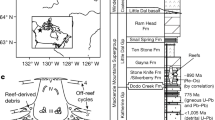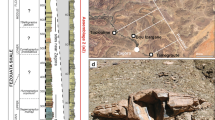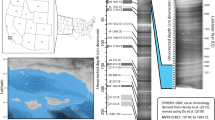Abstract
The Neoproterozoic era was punctuated by the Sturtian (about 710 million years ago) and Marinoan (about 635 million years ago) intervals of glaciation. In South Australia, the rocks left behind by the glaciations are separated by a succession of limestones and shales, which were deposited at tropical latitudes. Here we describe millimetre- to centimetre-scale fossils from the Trezona Formation, which pre-dates the Marinoan glaciation. These weakly calcified fossils occur as anvil, wishbone, ring and perforated slab shapes and are contained within stromatolitic limestones. The Trezona Formation fossils pre-date the oldest known calcified fossils of this size by 90 million years, and cannot be separated from the surrounding calcite matrix or imaged by traditional X-ray-based tomographic scanning methods. Instead, we have traced cross-sections of individual fossils by serially grinding and scanning each sample at a resolution of 50.8 μm. From these images we constructed three-dimensional digital models of the fossils. Our reconstructions show a population of ellipsoidal organisms without symmetry and with a network of interior canals that lead to circular apertures on the fossil surface. We suggest that several characteristics of these reef-dwelling fossils are best explained if the fossils are identified as sponge-grade metazoans.
This is a preview of subscription content, access via your institution
Access options
Subscribe to this journal
Receive 12 print issues and online access
$259.00 per year
only $21.58 per issue
Buy this article
- Purchase on Springer Link
- Instant access to full article PDF
Prices may be subject to local taxes which are calculated during checkout



Similar content being viewed by others
References
Preiss, W. in The Adelaide Geosyncline of South Australia, Late Proterozoic Stratigraphy, Sedimentation, Palaeontology and Tectonics Vol. 53 (ed. Preiss, W.) (Geological Survey of South Australia, 1987).
Fanning, C. M. Geological Society of America Abstracts with Programs Vol. 38, 115 (2006).
Schrag, D., Berner, R., Hoffman, P. & Halverson, G. On the initiation of a snowball Earth. Geochem. Geophys. Geosyst. 3, 1036 (2002).
Pavlov, A., Hurtgen, M., Kasting, J. & Arthur, M. Methane-rich Proterozoic atmosphere. Geology 31, 87–90 (2003).
Halverson, G., Maloof, A. & Hoffman, P. The Marinoan glaciation (Neoproterozoic) in northeast Svalbard. Basin Res. 16, 297–324 (2004).
Halverson, G. et al. Toward a Neoproterozoic composite carbon-isotope record. Geol. Soc. Am. Bull. 117, 1181–1207 (2005).
Condon, D. et al. U–Pb ages from the Neoproterozoic Doushantuo formation, China. Science 308, 95–98 (2005).
Hoffmann, K-H., Condon, D., Bowring, S. & Crowley, J. A U–Pb zircon date from the Neoproterozoic Ghaub Formation, Namibia: Constraints on Marinoan glaciation. Geology 32, 817–820 (2004).
Preiss, W. Palaeoecological interpretations of South Australian stromatolites. J. Geol. Soc. South Aust. 19, 501–532 (1973).
Watters, W. & Grotzinger, J. Digital reconstruction of calcified early metazoans, terminal Proterozoic Nama Group, Namibia. Paleobiology 27, 159–171 (2001).
Sutton, M., Briggs, D., Siveter, D. & Siveter, D. Methodologies for the visualization and reconstruction of three-dimensional fossils from the Silurian Herefordshire lagerstätte. Palaeontol. Electron. 4, 1–17 (2001).
Bentis, C., Kaufman, L. & Golubic, S. Endolithic fungi in reef-building corals (order: Scleractinia) are common, cosmopolitan, and potentially pathogenic. Biol. Bull. 198, 254–260 (2000).
James, N. & Kobluk, D. The oldest macroborers: Lower Cambrian of Labrador. Science 197, 980–983 (1977).
Riding, R. Microbial carbonates: The geological record of calcified bacterial-algal mats and biofilms. Sedimentology 47 (suppl. 1), 179–214 (2000).
Lawrence, J., Korber, D., Hoyle, B., Casterton, J. & Caldwell, J. Optical sectioning of microbial biofilms. J. Bacteriol. 173, 6558–6567 (1991).
Matz, M., Frank, T., Marshall, J., Widder, E. & Johnsen, S. Giant deep-sea protist produces bilaterian-like traces. Curr. Biol. 18, 1849–1854 (2008a).
Bengston, S. & Rasmussen, B. New and ancient trace makers. Science 323, 346–347 (2009).
Brusca, R. & Brusca, G. Invertebrates 2nd edn (Sinauer Associates, 2003).
Tendal, O. A monograph of the Xenophyophoria (Rhizopodea, Protozoa). Galathea Rep. 12, 7–99 (1972).
Walter, M., Oehler, J. & Oehler, D. Megascopic algae 1,300 million years old from the Belt supergroup, Montana: A reinterpretation of Walcott’s Helminthoidichnites. J. Paleontol. 50, 872–881 (1976).
Han, T. & Runnegar, B. Megascopic eukaryotic algae from the 2.1-billion-year-old Negaunee iron-formation, Michigan. Science 257, 232–235 (1992).
Wray, J. Calcareous Algae (Elsevier, 1977).
Laporte, L. Codiacean algae and algal stromatolites of the Manlius Limestone (Devonian) of New York. J. Paleontol. 37, 643–647 (1963).
Mierzejewski, P. Ultrastructure, taxonomy and affinities of some Ordovician and Silurian microfossils. Palaeontol. Pol. 47, 129–220 (1986).
Riding, R. Solenopora is a chaetetid sponge, not an alga. Palaeontology 47, 117–122 (2004).
Brooke, C. & Riding, R. Ordovician and Silurian coralline red algae. Lethaia 31, 185–195 (1998).
Xiao, S. et al. The Neoproterozoic Quruqtagh Group in eastern Chinese Tianshan: Evidence for a post-Marinoan glaciation. Precambr. Res. 130, 1–26 (2004).
Gehling, J. & Rigby, J. Long expected sponges from the Neoproterozoic Ediacaran Fauna of South Australia. J. Paleontol. 70, 185–195 (1996).
Grant, S. Shell structure and distribution of Cloudina, a potential index fossil for the terminal Proterozoic. Am. J. Sci. 290-A, 261–294 (1990).
Grotzinger, J., Watters, W. & Knoll, A. Calcified metazoans in thrombolite–stromatolite reefs of the terminal Proterozoioc Nama Group, Namibia. Paleobiology 26, 334–359 (2000).
Toporski, J. et al. Morphologic and spectral investigation of exceptionally well-preserved bacterial biofilms from the Oligocene Enspel formation, Germany. Geochim. Cosmochim. Acta 66, 1773–1791 (2002).
Briggs, D. The role of decay and mineralization in the preservation of soft-bodied fossils. Annu. Rev. Earth Planet. Sci. 31, 275–301 (2003).
Bosak, T. & Newman, D. Microbial nucleation of calcium carbonate in the Precambrian. Geology 31, 577–580 (2003).
Manuel, M. Phylogeny and evolution of calcareous sponges. Can. J. Zool. 84, 225–241 (2006).
Peterson, K., Cotton, J., Gehling, J. & Pisani, D. The Ediacaran emergence of bilaterians: Congruence between the genetic and the geological fossil records. Phil. Trans. R. Soc. B 363, 1435–1443 (2008).
Love, G. et al. Fossil steroids record the appearance of Demospongiae during the Cryogenian. Nature 457, 718–721 (2009).
Wallace, M. & Woon, E. Selwyn Symposium, Vol. Abstract 91 of Neoproterozoic Climates Origin of Early Life 17–21 (Geological Society of Australia Victoria Division, 2008).
Neuweiler, F., Turner, E. & Burdige, D. Early Neoproterozoic origin of the metazoan clade recorded in carbonate rock texture. Geology 37, 475–478 (2009).
Xiao, S., Zhang, Y. & Knoll, A. Three-dimensional preservation of algae and animal embryos in a Neoproterozoic phosphorite. Nature 391, 553–558 (1998).
Li, C., Chen, J. & Hua, T. Precambrian sponges with cellular structures. Science 279, 879–882 (1998).
Bengston, S., Conway Morris, S., Cooper, B., Jell, P. & Runnegar, B. Early Cambrian fossils from South Australia. Mem. Assoc. Aust. Palaeontol. 1–364 (1990).
Sperling, E., Robinson, J., Pisani, D. & Peterson, K. Where’s the glass? Biomarkers, molecular clocks, and microRNAs suggest a 200-Myr missing Precambrian fossil record of siliceous sponge spicules. Geobiology 8, 24–36 (2010).
Sperling, E., Pisani, D. & Peterson, K. in The Rise and Fall of the Ediacaran Biota, Vol. 286 (eds Vickers-Rich, P. & Komarower, P.) 355–368 (Geol. Soc. Lond. Spec. Publ., 2007).
Xiao, S. & Laflamme, M. On the eve of animal radiation: Phylogeny, ecology, and evolution of the Ediacara biota. Trends Ecol. Evol. 24, 31–40 (2009).
Swanson-Hysell, N. et al. Cryogenian glaciation and the onset of carbon-isotope decoupling. Science 328, 608–611 (2010).
Acknowledgements
W. Watters provided us with example imagery, and, along with J. Hawthorne, gave us helpful Matlab advice. B. Evans allowed us to use his precision grinding machine at MIT, E. Feldman provided useful advice about machine design and machine code and S. Myneni helped us with the ATR-FTIR spectroscopy. We would like to thank B. E. Girit, W. A. Rozen, S. Briedfjord and A. Lukyanov of Situ Studio. B. Dyer, J. Strauss, N. Swanson-Hysell and N. Xu assisted with field work. S. Bowring, T. Duffy, J. Grotzinger, A. Knoll, M. Manuel, S. Porter, E. Sperling, G. Subsol and S. Xiao provided stimulating discussion. Flinders National Park and numerous pastoralists graciously allowed us to conduct field work on their land. The research was financially supported by NSF-EAR0842946 to A.C.M. and NSF-DMR-0819860 to the Princeton Center for Complex Materials.
Author information
Authors and Affiliations
Contributions
A.C.M. and C.V.R. conducted the field work. C.V.R. carried out the serial grinding and imaging. R.B., B.M.S., C.V.R., C.C.C., F.J.S. and A.C.M. did the 3D modelling. G.R.P., N.Y., A.C.M. and C.V.R. did the E-SEM EDX analyses. C.V.R. conducted the ATR-FTIR spectroscopy. A.C.M. and D.H.E. wrote the paper.
Corresponding author
Ethics declarations
Competing interests
The authors declare no competing financial interests.
Supplementary information
Supplementary Information
Supplementary Information (PDF 6083 kb)
Rights and permissions
About this article
Cite this article
Maloof, A., Rose, C., Beach, R. et al. Possible animal-body fossils in pre-Marinoan limestones from South Australia. Nature Geosci 3, 653–659 (2010). https://doi.org/10.1038/ngeo934
Received:
Accepted:
Published:
Issue Date:
DOI: https://doi.org/10.1038/ngeo934
This article is cited by
-
Respiration kinetics and allometric scaling in the demosponge Halichondria panicea
BMC Ecology and Evolution (2023)
-
Factors affecting the isolation and diversity of marine sponge-associated bacteria
Applied Microbiology and Biotechnology (2022)
-
Genes, the brain, and artificial intelligence in evolution
Journal of Human Genetics (2021)
-
Insights into the origin of metazoan multicellularity from predatory unicellular relatives of animals
BMC Biology (2020)
-
Neoproterozoic copper cycling, and the rise of metazoans
Scientific Reports (2019)



